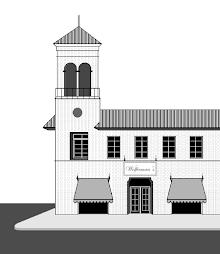
As the 20th century progressed, the size of the standard American supermarket expanded considerably. In the 1930s, a typical store might have been in the 5,000 to 10,000 square foot range. By the 1960s, the 20,000 to 30,000 square foot model was the norm. This figure had increased to 50,000 square feet by the 1980s and to 65,000 square feet by the 1990s.
They often say that what is old is new again. This could also be said about the American Shopping Mall Supermarket. Gone and forgotten by the 1980s, the Mall Market has made something of a resurgence in the 21st century. While it can't be said that every single shopping mall in this day and age has a grocery outlet as a trip generator, such things have become much more common than they were only 20 years ago.
The biggest food retail push into the typical American mall has been done by that well-known Arkansas-based retailer...the world's largest by any type of classification. WalMart Stores' SuperCenter concept, first introduced in 1988, includes a full-fledged supermarket and has now been adapted into a few shopping center applications. A few examples are SuperCenters at Phoenix's CHRISTOWN SPECTRUM and Greater Miami's MALL AT 163rd STREET.
Washington State's Costco chain, whose stores carry food and general merchandise, has also established a shopping mall presence over the past few years. Earlier mall-based locations were mallway-connected. However, the newer norm seems to be for Costco to purchase and raze an existing (and vacant) department store and replace it with a freestanding Costco, with no interior mall connection. Case(s) in point, the Costco at Cobb County Georgia's CUMBERLAND MALL or Spartanburg, South Carolina's WESTGATE MALL.
Minnesota's Target chain has also adapted its food-selling SuperTarget model into a mall-based format. Examples are the SuperTargets at Balcones Heights, Texas' WONDERLAND OF THE AMERICAS and Sunrise, Florida's SAWGRASS MILLS.


